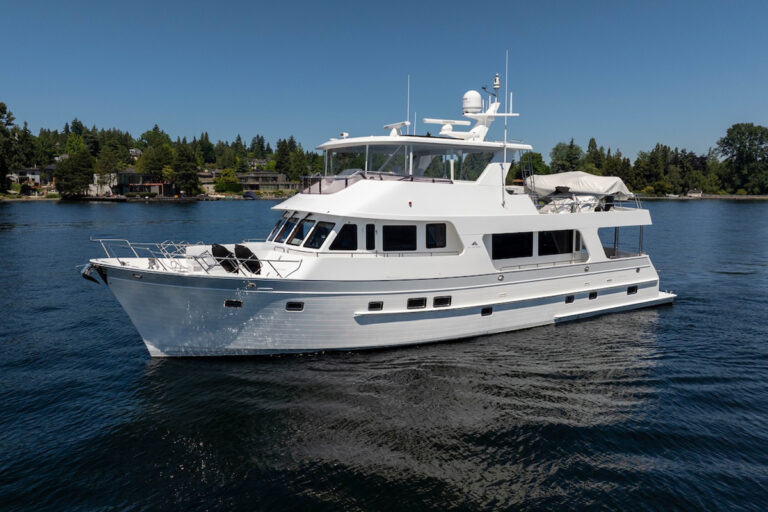My crew and I had to laugh. While the NOAA forecast on the VHF predicted clear and sunny skies for our exact location, we were being pelted with hail, tossed by high winds and drenched with driving rain from a molasses sky. Since we were out for only a day cruise in local waters and within sight of land, we had foolishly ignored developing weather around us and relied only on the weather information over the airways.
Although weather reports gained by VHF, weatherfax or satellite are useful, and the ability to gather them quickly has increased over the years, our situation made it clear that knowing how to observe the surroundings and formulate a weather prediction is the key to avoiding surprises. Even with a helm full of the latest electronics, an important part of putting together your own forecast is observing and interpreting clouds and cloud formations.
Clouds are among the most visible indicators of weather and can often help predict thunderstorms, an approaching front, rain or a squall. Learning to interpret the sky remains part of a basic course for U.S. Coast Guard recruits. Every yachtsman, no matter where he cruises, should fine-tune the skill of interpreting clouds.
Start by learning to identify cloud forms and how they may affect weather. This may feel like your kid’s eighth-grade science project, but it’s a necessary first step. Although there are infinite shapes a cloud can take, the common classification system includes 10 types: cumulonimbus, cumulus, stratus, stratocumulus, nimbostratus, altostratus, altocumulus, cirrostratus, cirrocumulus and cirrus. It is important to learn the characteristics of each cloud type. Books such as Chapman Piloting offer a good overview and helpful pictures.
Next, watch how clouds form in your area, determine whether they are increasing or decreasing in amount, and understand what shape they are taking. As a general rule, lowering or thickening cloud formations indicate wet weather is on the way. Then, begin to combine this information with other items such as barometric pressure and wind velocity.
For example, the formation of a thunderstorm can be observed by watching a cumulonimbus cloud. This vertically formed cloud often stands on a base of lower, ragged clouds that may merge with the towering portion of the cloud. A telltale sign of a cumulonimbus is the flat top. This top layer leans in the same direction the wind is blowing. The main body of a thunderstorm cloud is a large cumulus with cauliflower-like sides. Once the leading edge of the cumulus base begins to bunch up in rolls due to violent winds, chances are a thunderstorm is forming. If you know what to look for, you can spot a storm brewing before the cloud’s dark center area, which indicates rain, starts to form.
The altitude of a cumulonimbus cloud can often indicate the potential severity of the storm. Usually, the higher the formation is in the sky, the more severe the storm. Plus, if the cloud lacks a distinct, flat top like the bottom photo on the previous page, and the roll cloud is not forming at the base, you will be in for only a heavy soaking. This often happens in the Caribbean, where this formation was photographed, or other tropical areas where bursts of afternoon showers are the norm.
Another important element of forecasting is being aware of approaching fronts. This is especially true when you are on an extended offshore cruise, and the forecast is set for a larger, generalized area. When fronts pass through, the result is a change of weather, often for the worse. A cold front can be indicated in warm weather when clouds lower and cumulus clouds begin to tower above, due to warm air being displaced by approaching cold air. Also, altocumulus clouds, shown on the bottom picture of the next page, which look like fuzzy bubbles in long rows, are usually an early warning sign that a cold front is coming. If it’s summertime or you’re in the tropics with warm, humid air, these clouds may turn into thunderstorms as the cold front approaches. Barometric pressure will also decrease, often rapidly, and a squall line will usually accompany the front.
Clouds and a falling barometric pressure can also indicate a warm front. As a warm front approaches, clouds build up and the pressure falls. Cirrus clouds can first be seen, followed by cirrostratus, then altostratus and, finally, nimbostratus (top photo, this page), which develop in the rain area. After the warm front has passed through, cumulus and/or stratocumulus clouds will form and begin to rise again.
Clouds can help you gauge a fair day, as well. For instance, the scattered, cotton ball-like cumulus clouds shown in the top picture on the next page indicate fair weather. They will have large spaces of clear sky between them. However, keep an eye on them and make sure they don’t develop into storm clouds, as described previously. A complete layer of altostratus clouds will usually indicate warm days, and high-flying cirrus clouds with little mass can also signal fair weather.
Although the sophistication of today’s satellite weather systems and the accuracy of NOAA forecasts may eliminate the need for these skills on a daily basis, it’s wise to be aware of your surroundings and compare your forecasting skills with your equipment to keep your forecasting skills sharp. Like anything on a boat, having a good backup only adds to safety and enjoyment.









